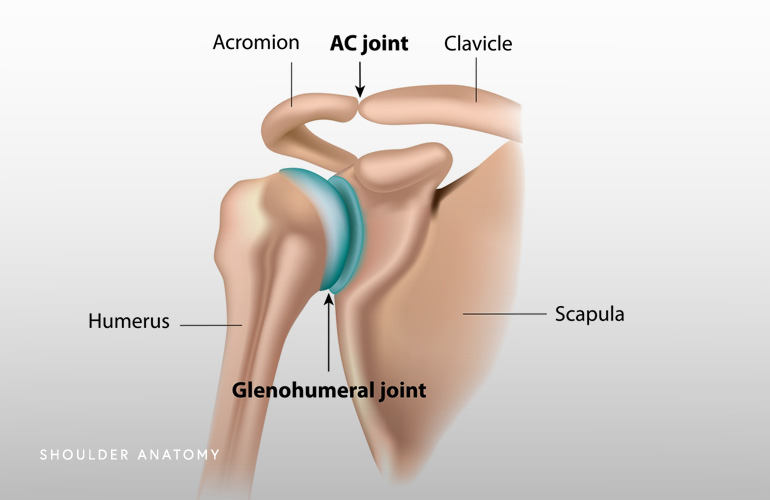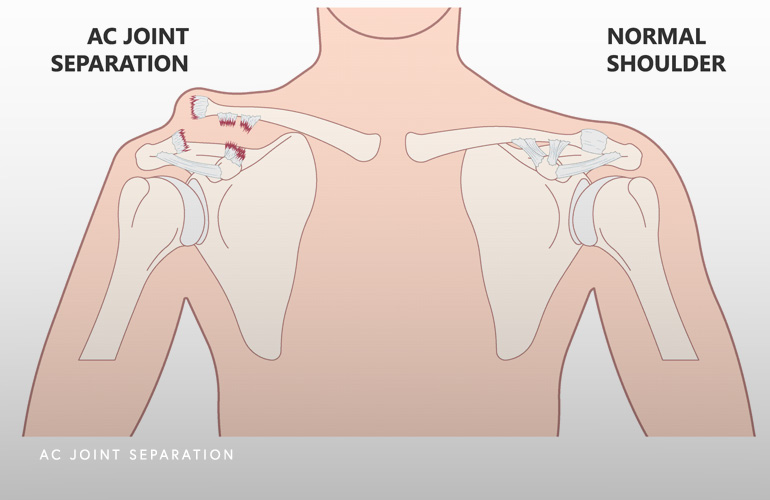Acromioclavicular Joint Conditions
Collarbone (acromioclavicular) joint injuries
The collarbone (acromioclavicular) joint is a special joint in near the shoulder that deserves special attention as it is a common site of injury and sometimes pain, but is less commonly involved than the main ball and socket (“glenohumeral”) joint, and has separate treatment considerations.
The acromioclavicular joint “AC joint” is the joint where the shoulder blade meets the rest of the skeleton at the collarbone. The shouler blade part of the AC joint is called the acromion and the collarbone is called the clavicle, and the meeting of these two structures to form a joint is called the acromioclavicular joint. Like any joint in the body, there is specific cartilage and movement between these bones at the AC joint, although the motion of the bones is somewhat restricted when compared with the bigger glenohumeral joint.

Much like any joint in the body, the acromioclavicular joint can become arthritic, where the smooth lining surfaces of the joint wear out. When the cartilage wears out, the joint space narrows, bone spurs develop, and cysts and edema or fluid around the joint develops. This causes pain which is commonly experienced at the top of the shoulder and sometimes can radiate into the lower neck or “trapezial” region. Reaching across the body towards the other arm and sometimes reaching up the back can worsen pain coming from the AC joint.
Sometimes, arthritis of the acromioclavicular joint can be what is called asymptomatic, in other words does not cause a problem. It is common to develop arthritis of the AC joint with age, and sometimes AC joint arthritis is diagnosed along with other conditions of the shoulder, such as a rotator cuff tear. Shoulder surgeon Dr. Obermeyer will perform a detailed physical examination of you and correlate any imaging studies with your symptoms to determine if treatment for an arthritic AC joint is needed.
Activities frequently causing pain at the acromioclavicular joint are those that typically involve forceful movement of the arm towards the midline of the body. This motion of the shoulder is termed “adduction”. The classic example of this is a bench press or a push-up where the arm is forcefully moved from out towards in at the chest, generating a strain at the AC joint. Sometimes this painful condition in weightlifters can cause cycles of injury and repair (inflammation), which leads to a problem called osteolysis. This diagnosis can be confirmed on your physical examination and often is confirmed on an MRI.
Treatment for an arthritic or painful AC joint
The treatment of a painful AC joint, once the diagnosis is confirmed, is to initially modify activities, and avoid activities that cause further strain and injury to the area. Weight lifters sometimes may change their technique for lower weights and higher repetitions, or modify the lifts so that the bar does not go all the way down to the chest (or a “three-quarters” lift).
Medications taken orally and ice can often calm the irritation of a painful AC joint. Sometimes a steroid injection can be used to stop the pain, break the cycle of inflammation, and allow the body to recover. If this fails, shoulder surgeon Dr. Obermeyer will discuss a minimally invasive arthroscopic procedure with you called a distal clavicle resection, where the joint is removed with a tiny instrument about the thickness of a pencil called a bur. This effectively removes the diseased and painful AC joint permanently, so there is no possibility the pain recurs or comes back.
A common injury mechanism in athletes and weekend warriors alike is when a patient falls on the tip of the shoulder. This is often seen in bicycle injuries and sporting events when the athlete falls onto the tip of the shoulder, effectively driving in the shoulder blade into the chest. This injury causes a rupture of one or more groups of ligaments that connect the AC joint together and to the scapula (shoulder blade). There is a classification system for these injuries based on your xrays which guides treatment. Generally speaking, the more severe the injury, the more severe the ligament injury which causes a bump at the top of the shoulder.

The treatment of AC separations depends on the patient age, activity expectations, and severity of the injury. You will notice a bump on the top of the shoulder with many AC separations, which sometimes will be permanent without surgical repair. Not all of these injuries require surgery, however, and Dr. Obermeyer will help you decide which treatment option is best in your individual circumstances.
When AC separations occur for the first time, the ligaments are freshly (acutely) ruptured and if surgery is elected, a suture repair can be used to temporarily hold the bones in position while the ligaments heal. When the injury is more chronic, and the problem has become painful to the extent surgery is elected, the ligaments cannot heal on their own and require replacement of the ligament tissue in a procedure called a reconstruction. Oftentimes when this procedure is required a cadaver (allograft) tendon is used to replace your native ligament tissue. Dr. Obermeyer will review the particulars of this procedure and how the operation works and will be tailored to your individual circumstances.
Schedule an orthopedic appointment
If you have symptoms consistent with an AC Joint condition, call our office or book an appointment with shoulder surgeon Dr. Thomas Obermeyer. Dr. Obermeyer specializes in diagnosing and treating shoulder injuries. Dr. Obermeyer has orthopedic offices in Schaumburg, Bartlett, and Elk Grove Village, Illinois. Dr. Obermeyer regularly sees patients from throughout Illinois including Hoffman Estates, Palatine, Elgin, Streamwood, Arlington Heights, and Roselle communities.
At a Glance
Dr. Thomas Obermeyer
- 15+ years of training and experience treating complex shoulder and sports medicine conditions
- Expert subspecialized and board-certified orthopedic care
- Award-winning outstanding patient satisfaction scores
- Learn more

